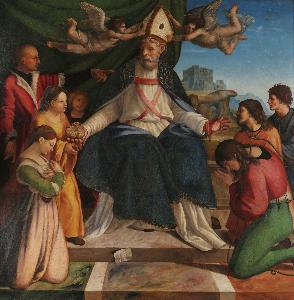Andrea Da Salerno
Andrea Da Salerno;Andrea Sabbatini
Place: Salerno
Born: 1487
Death: 1530
Biography:
Andrea Da Salerno, also known as Andrea Sabbatini, was a prominent Italian painter of the Renaissance period. Born in Salerno in 1487, he initially trained under Raimondo Epifanio in Naples, but later moved to Rome and became a close disciple of the renowned artist Raphael.
Artistic Career
Andrea Da Salerno's artistic career was marked by the creation of numerous important paintings with religious motives. Some of his notable works include The Adoration of the Cross, The Seven Church Teachers, and Madonna with Child. These paintings are characterized by their beautiful compositions, vibrant colors, and attention to detail. Andrea Da Salerno's style was heavily influenced by his mentor Raphael, and his works showcase a unique blend of Renaissance and Mannerist elements. His paintings can be found in various museums, including the Museum of Naples, where they continue to inspire art lovers and scholars alike.
Notable Works and Collections
Some of Andrea Da Salerno's notable works include:
- St. Nicholas of Bari on the Bishop’s Throne, a painting that can be found in the Palace of Capodimonte in Naples, Italy.
- The Adoration of the Cross, a painting that showcases his mastery of composition and color.
- The Seven Church Teachers, a painting that highlights his ability to create intricate and detailed scenes.
Andrea Da Salerno's works can be found in various collections, including the Pinacoteca Comunale of Forlì and the Museo Nazionale di Capodimonte. These collections provide a glimpse into the artist's creative genius and his contribution to the Renaissance art movement.
Legacy
Andrea Da Salerno's legacy as a painter is undeniable. His works continue to inspire artists, scholars, and art lovers alike. For more information about Andrea Da Salerno and his works, visit Andrea Da Salerno on Wikioo.org or check out the Wikipedia page dedicated to this remarkable artist. Some of his paintings can also be found in the Pinacoteca Comunale of Forlì, Italy, and the Palace of Capodimonte (Naples, Italy). Andrea Da Salerno's artistic genius is a testament to the enduring power of Renaissance art. His works continue to captivate audiences and inspire new generations of artists and scholars.


